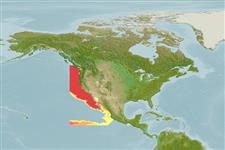>
Gadiformes (Cods) >
Merlucciidae (Merluccid hakes)
Etymology: Merluccius: Latin, mar, maris = the sea + Latin, lucius = pike (Ref. 45335).
More on author: Ayres.
Environment: milieu / climate zone / depth range / distribution range
Ekologi
laut; payau; kisaran kedalaman 0 - 1000 m (Ref. 9316), usually ? - 229 m (Ref. 2850). Temperate; 51°N - 15°N, 130°W - 77°W (Ref. 58452)
Eastern Pacific: northern Vancouver Island, Canada to northern part of the Gulf of California. A record from the Gulf of Alaska is doubtful.
Length at first maturity / Size / Weight / umur
Maturity: Lm 37.0, range 34 - 40 cm
Max length : 83.0 cm TL jantan/; (Ref. 127973); 105.0 cm TL (female); common length : 60.0 cm TL jantan/; (Ref. 1371); Berat maksimum terpublikasi: 4.2 kg (Ref. 127973); Berat maksimum terpublikasi: 4.2 kg; Umur maksimum dilaporkan: 16 Tahun (Ref. 56527)
Duri punggung (Keseluruhan (total)): 1; duri punggung lunak (Keseluruhan (total)): 48-56; Duri dubur 0; Sirip dubur lunak: 40 - 43. Head rather short. Pectoral fin tips usually reaching to or beyond the origin of anal fin. Caudal fin always concave. Color silvery on back grading to whitish ventrally.
Inhabit oceanic and coastal areas, but mainly on the continental shelf (Ref. 1371). Although often classified as demersal, the distribution and behavior suggest a largely pelagic existence (Ref. 1371). Adults live in large schools in waters overlying the continental shelf and slope except during the spawning season when they are found several hundred miles seaward (Ref. 1371). A nocturnal feeder (Ref. 6885) that feed on a variety of fishes and invertebrates (Ref. 1371). Important prey for sea lions and small cetaceans (Ref. 2850); also prey of dogfish (Ref. 11384).
Cohen, D.M., T. Inada, T. Iwamoto and N. Scialabba, 1990. FAO species catalogue. Vol. 10. Gadiform fishes of the world (Order Gadiformes). An annotated and illustrated catalogue of cods, hakes, grenadiers and other gadiform fishes known to date. FAO Fish. Synop. 125(10). Rome: FAO. 442 p. (Ref. 1371)
Status IUCN Red List (Ref. 130435)
ancaman kepada manusia
Harmless
penggunaan manusia
Perikanan: bernilai komersial tinggi
informasi lanjut
mitraGambarStamps, Coins Misc.Suara-suaraCiguateraKecepatanTipe renangArea insangOtolithsOtakPenglihatan / visi
Alat, peralatan
laporan khas
muat turun XML
Sumber internet
Estimates based on models
Preferred temperature (Ref.
123201): 7 - 12.6, mean 8.6 °C (based on 23 cells).
Phylogenetic diversity index (Ref.
82804): PD
50 = 0.5000 [Uniqueness, from 0.5 = low to 2.0 = high].
Bayesian length-weight: a=0.00457 (0.00381 - 0.00548), b=3.10 (3.05 - 3.15), in cm total length, based on LWR estimates for this species (Ref.
93245).
Trophic level (Ref.
69278): 4.4 ±0.0 se; based on diet studies.
Daya lenting (Ref.
120179): sedang, Waktu penggandaan populasi minimum 1.4 - 4.4 tahun (tmax=17; tm=4; also Musick et al. 2000 (Ref.
36717)).
Prior r = 0.49, 95% CL = 0.33 - 0.74, Based on 3 stock assessments.
Fishing Vulnerability (Ref.
59153): Moderate vulnerability (43 of 100).
Climate Vulnerability (Ref.
125649): Moderate to high vulnerability (53 of 100).
Nutrients (Ref.
124155): Calcium = 10.2 [5.9, 23.4] mg/100g; Iron = 0.258 [0.108, 0.535] mg/100g; Protein = 18.1 [17.0, 19.4] %; Omega3 = 0.307 [0.183, 0.505] g/100g; Selenium = 21.6 [9.0, 51.7] μg/100g; VitaminA = 17.2 [5.7, 53.3] μg/100g; Zinc = 0.357 [0.261, 0.491] mg/100g (wet weight); based on
nutrient studies.
